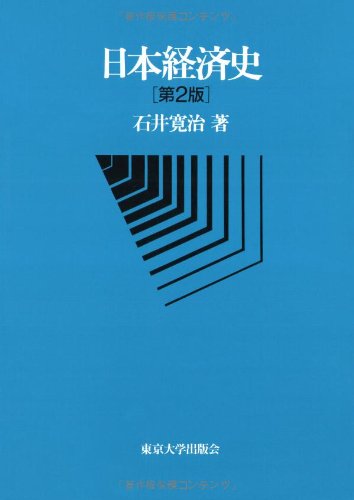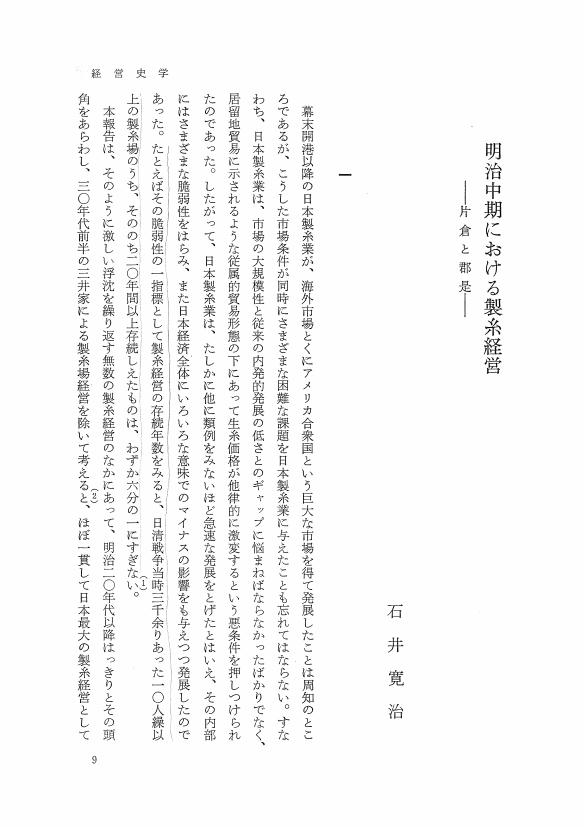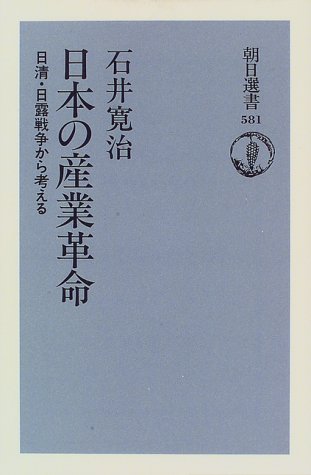17 0 0 0 OA 実験用ヘリコプタMuPAL-ε活用実績概要
- 著者
- 奥野 善則 又吉 直樹 石井 寛一 小林 啓二 Okuno Yoshinori Matayoshi Naoki Ishii Hirokazu Kobayashi Keiji
- 出版者
- 宇宙航空研究開発機構(JAXA)
- 雑誌
- 宇宙航空研究開発機構研究開発資料 = JAXA Research and Development Memorandum (ISSN:13491121)
- 巻号頁・発行日
- vol.JAXA-RM-15-001, pp.1-47, 2015-12-09
JAXAの実験用ヘリコプタMuPAL-ε(ミューパル・イプシロン)は,我が国初の純国産民間ヘリコプタであるMH2000A型機を母機とし,様々な飛行実験に対応可能な実験用システムを搭載して開発された.2000年4月の運用開始から2013年2月の運用終了まで,JAXA内外の多くの研究開発に活用された.本稿では,その主な活用事例と研究開発成果の概要について報告する.
- 著者
- 石井 寛治
- 出版者
- 青木書店
- 雑誌
- 歴史学研究 (ISSN:03869237)
- 巻号頁・発行日
- no.729, pp.2-10, 1999-10
6 0 0 0 IR 維新経済史再考--多摩シルクロードの人々
- 著者
- 石井 寛治
- 出版者
- 東京経済大学
- 雑誌
- 東京経大学会誌. 経営学 (ISSN:13486411)
- 巻号頁・発行日
- no.258, pp.243-255, 2008-03-05
- 著者
- 石井 寛
- 出版者
- 一般財団法人林業経済研究所
- 雑誌
- 林業經濟 (ISSN:03888614)
- 巻号頁・発行日
- vol.65, no.8, pp.16-22, 2012-11-20
3 0 0 0 OA 幕末経済史再考
- 著者
- 石井 寛治
- 出版者
- 日本学士院
- 雑誌
- 日本學士院紀要 (ISSN:03880036)
- 巻号頁・発行日
- vol.74, no.2, pp.65, 2019 (Released:2020-01-16)
- 参考文献数
- 27
The industrial revolution in Japan in the latter half of the 19th century, the first industrial revolution in Asia, did not depend on foreign capital until 1899, when the Japanese government called off the prohibition on foreign capital investment. This change was a result of Japanese law courts beginning to consider the crimes of foreigners in Japan. Even after 1899, the amount of foreign capital used in private enterprises within Japan was unexpectedly small. In 1914, only 7% of all stocks and debentures of private enterprises were foreign-owned. How did Japanese entrepreneurs then raise money for industrialization? Big enterprises raised money domestically through joint-stock companies. The stockholders invested not only their own money but also money borrowed from banks using their stocks as security. Most stockholders were merchants and financiers, including those who started their businesses in the Edo era. Although the loan business with the merchants set up by the biggest moneychangers, such as Mitsui and Kounoike, was said to be declining toward the end of the Edo era, it is notable that the draft business, which promoted modernization of the economy, was growing. In Japan, payment to distant clients by bills of exchange began in the 13th century, and payment to nearby clients by such bills began in the 17th century. However, Japanese moneychangers did not develop a business around discounting bills because Japanese merchants did not use terminable promissory notes. In this paper, I first discuss cases of settlement of transactions involving cotton goods and fertilizers between Owari (present-day western Aichi Prefecture) and Edo (present-day Tokyo) by bills of exchange. I also discuss cases of settlement for trade of cotton goods and tea between Yokohama and Kamigata (present-day Osaka and Kyoto) by bills of exchange. The latter cases were important in keeping foreign merchants from making inroads into Japan’s market. It also led to Japanese merchants accumulating capital via cash payments with foreign merchants in Yokohama. I then discuss cases of settlement among merchants by bills of exchange in Kamigata in the late Edo era. Such settlements became common in Osaka as well as its suburbs, thereby reducing the loan interest rate to approximately 6%, which was almost half of that in Edo. In Osaka, bills of exchange could be settled by many moneychangers who were further controlled by the biggest moneychangers, particularly Kounoike, Mitsui, and Kajimaya. Contrary to popular belief that Mitsui was in financial straits by the end of the Edo era, the real situation of Mitsui was promising when the draft business was taken into account. Although many moneychangers went bankrupt during the Meiji Reform, a considerable number of them survived the phase. Additionally, many powerful newcomers such as Chojiya, Nunoya, and Yasuda began operating during this period. Some of these moneychangers even established modern banks. The most important suppliers of capital for the industrialization in Japan were the merchants, both old and new, headed by moneychangers.
3 0 0 0 OA 北欧におけるシラカンバ花粉症対策の現状
- 著者
- 尾張 敏章 石井 寛 間口 四郎
- 出版者
- 北海道大学農学部演習林
- 雑誌
- 北海道大学農学部 演習林研究報告 (ISSN:03676129)
- 巻号頁・発行日
- vol.58, no.1, pp.7-27, 2001-03
1 0 0 0 OA 在宅非侵襲的陽圧換気療法が奏功した胸痛を呈する難治性喘息の2例
- 著者
- 鳥羽 聡史 石井 寛 山形 英司 泥谷 純子 門田 淳一
- 出版者
- 一般社団法人 日本アレルギー学会
- 雑誌
- アレルギー (ISSN:00214884)
- 巻号頁・発行日
- vol.62, no.8, pp.980-985, 2013-08-30 (Released:2017-02-10)
胸痛をともなう難治性喘息に対して非侵襲的陽圧換気(noninvasive positive pressure ventilation; NPPV)を使用し,改善を認めた2例を経験した.2例はいずれも女性で,治療ステップ4でも喘息コントロールに乏しく,胸痛によるQOL低下もきたしていた.外来で30分程度のNPPVを試行したところ症状の改善を認めたため,間欠的な在宅NPPVを導入した.NPPVは3〜5カ月間使用したが,いずれの症例も喘息コントロールの改善とともに胸痛も消失したため,NPPVを離脱した.呼吸機能については,肺活量や一秒量の変化は認めなかったものの,末梢気道狭窄の指標となるV^^・50やV^^・25が改善した.胸痛をともなう難治性喘息では,非薬物療法であるNPPVが末梢気道の気流制限を改善することで,QOL向上の一助になる可能性が示唆された.
- 著者
- 石井 寛海 阿南 雅也 森 淳一 山口 豊
- 出版者
- 公益社団法人 日本理学療法士協会
- 雑誌
- 理学療法学Supplement
- 巻号頁・発行日
- vol.46, pp.H2-225_1-H2-225_1, 2019
<p>【症例紹介】変形性膝関節症(以下,膝OA)患者の人工膝関節置換術(以下,TKA)後の理学療法は,下肢筋力トレーニング,関節可動域運動,歩行練習などが一般的に行われている.大腿四頭筋の筋力は,TKA後の最初の数週間にてTKA前よりもより低下するとされており,その筋力低下はTKA後数年経っても完全には解決できていないことが報告されている.TKA後の大腿四頭筋の筋力低下の原因は,単独で生じる筋萎縮のみならず,手術侵襲,術後安静,および関節原性筋抑制(以下,AMI)も挙げられる.また,膝OA患者の神経筋系の特徴として,膝周囲筋群の共同収縮が挙げられる.膝OA患者は歩行時の膝関節周囲筋の共同収縮が増大するとの報告があり,膝関節の病態を取り除いたTKA後の歩行でも報告されている.そこで今回、膝OA後のTKAを施行した症例に対し,膝関節周囲筋の共同収縮に着目し,質的な筋機能の改善を目的として介入した症例を報告する.</p><p> 症例は80歳,女性.数年前より膝関節痛のため階段昇降や長距離歩行が困難となった.1年前に左膝TKA施行し,今回は急性期病院にて右膝TKAを施行し術後3週で当院へ入院された.主訴は,「膝が曲がるようになってほしい、バスに乗りたい.」であった.</p><p>【評価とリーズニング】当院入院1週間後に初期評価を実施した.右膝関節可動域は他動運動で膝屈曲120°/膝伸展−5°,自動運動では屈曲105°/伸展-5°.右膝関節屈曲時に術創部,大腿直筋の伸張痛あり.NRSは2/10,圧痛は無く軽度の熱感あり.膝伸展筋力はMMT4レベル.Extension lagは陰性.共同収縮の評価は座位での膝伸展運動時における共同収縮の指標であるCo-Contraction Index(以下,CCI)とした.表面筋電計NORAXON(酒井医療)を使用し,膝伸展運動時の筋電図を計測した.被検筋は外側広筋(以下,VL)・内側広筋(以下,VM)・外側ハムストリングス(以下,LH)・内側ハムストリングス(以下,MH)・腓腹筋外側頭(以下,LG)・腓腹筋内側頭(以下,MG)とした.CCIはFalconarらが推奨する算出方法にて,VMとMH,VMとMG,VLとLG,VLとLG間で算出した.CCIは値が大きい程より共同収縮が強いことを示し,膝関節伸展運動時のCCI(%)は,VM:MHは57,VM:MGは33,VL:LGは76,VL:LGは64であった.</p><p>【介入内容および結果】質的な筋機能の改善を目的に,端座位での膝伸・屈曲展運動を10回3セット実施した. 膝下垂位から3秒間で膝最大伸展位になるように膝伸展運動を行い,その後3秒間で膝下垂位となるように膝屈曲運動を意識して行うように指導した.その他,理学療法内容として関節可動域運動や歩行練習,階段昇降練習を1週間実施した.</p><p>結果,関節可動域やNRS,MMT, Extension lagに変化はなかった.膝関節伸展運動時のCCI(%)は,VM:MHは57→41,VM:MGは33→17,VL:LGは76→54,VL:LGは64→33と全てにおいて減少した.</p><p>【結論】本症例では,質的な筋機能の改善のために端座位での単関節運動による開放的運動連鎖(以下,OKC)のトレーニングを行った.特に,膝伸展筋である大腿四頭筋を求心性収縮と遠心性収縮にて選択的に促通した.その結果,初期評価時に共同収縮は高い数値を示していたが,1週間後には軽減していた.先行研究では,TKA後1ヶ月での大腿四頭筋の筋活性化は,筋力の大きさと同様に術前よりもさらに低下するとされている.介入期間を考慮すると,主動作筋である大腿四頭筋と拮抗筋であるハムストリングスの相反抑制を正しく再学習することで共同収縮の改善に至ったのではないかと考える.このことから,TKA後には筋力トレーニングによって量的な改善を促すより,質的な改善を目指すことで質的な筋機能の向上が期待できることが明らかになった.しかしながら,実際に随意的な筋活性化が改善されたかどうかは,本症例では明らかにできてはいない.今後,共同収縮と随意的な筋活性化の関係性や共同収縮を効果的に改善する運動療法を模索・検証していきたい.</p><p>【倫理的配慮,説明と同意】本研究はヘルシンキ宣言に基づき当該病院の倫理審査委員会の承認(A0017)と被験者の同意を得て実施した.</p>
1 0 0 0 幕末経済史再考:――手形取引の発展
- 著者
- 石井 寛治
- 出版者
- 日本学士院
- 雑誌
- 日本學士院紀要 (ISSN:03880036)
- 巻号頁・発行日
- vol.74, no.2, 2019
The industrial revolution in Japan in the latter half of the 19th century, the first industrial revolution in Asia, did not depend on foreign capital until 1899, when the Japanese government called off the prohibition on foreign capital investment. This change was a result of Japanese law courts beginning to consider the crimes of foreigners in Japan.<br> Even after 1899, the amount of foreign capital used in private enterprises within Japan was unexpectedly small. In 1914, only 7% of all stocks and debentures of private enterprises were foreign-owned. How did Japanese entrepreneurs then raise money for industrialization?<br> Big enterprises raised money domestically through joint-stock companies. The stockholders invested not only their own money but also money borrowed from banks using their stocks as security. Most stockholders were merchants and financiers, including those who started their businesses in the Edo era. Although the loan business with the merchants set up by the biggest moneychangers, such as Mitsui and Kounoike, was said to be declining toward the end of the Edo era, it is notable that the draft business, which promoted modernization of the economy, was growing.<br> In Japan, payment to distant clients by bills of exchange began in the 13th century, and payment to nearby clients by such bills began in the 17th century. However, Japanese moneychangers did not develop a business around discounting bills because Japanese merchants did not use terminable promissory notes.<br> In this paper, I first discuss cases of settlement of transactions involving cotton goods and fertilizers between Owari (present-day western Aichi Prefecture) and Edo (present-day Tokyo) by bills of exchange. I also discuss cases of settlement for trade of cotton goods and tea between Yokohama and Kamigata (present-day Osaka and Kyoto) by bills of exchange. The latter cases were important in keeping foreign merchants from making inroads into Japan's market. It also led to Japanese merchants accumulating capital via cash payments with foreign merchants in Yokohama.<br> I then discuss cases of settlement among merchants by bills of exchange in Kamigata in the late Edo era. Such settlements became common in Osaka as well as its suburbs, thereby reducing the loan interest rate to approximately 6%, which was almost half of that in Edo.<br> In Osaka, bills of exchange could be settled by many moneychangers who were further controlled by the biggest moneychangers, particularly Kounoike, Mitsui, and Kajimaya. Contrary to popular belief that Mitsui was in financial straits by the end of the Edo era, the real situation of Mitsui was promising when the draft business was taken into account.<br> Although many moneychangers went bankrupt during the Meiji Reform, a considerable number of them survived the phase. Additionally, many powerful newcomers such as Chojiya, Nunoya, and Yasuda began operating during this period. Some of these moneychangers even established modern banks. The most important suppliers of capital for the industrialization in Japan were the merchants, both old and new, headed by moneychangers.
1 0 0 0 OA 不凍タンパク質の実用化への取り組み
- 著者
- 石井 寛崇 井上 敏文
- 出版者
- 国立研究開発法人 産業技術総合研究所
- 雑誌
- Synthesiology (ISSN:18826229)
- 巻号頁・発行日
- vol.12, no.2, pp.84-91, 2019 (Released:2019-10-30)
- 参考文献数
- 3
不凍タンパク質は氷結晶に吸着し、その成長を抑制する機能を有するユニークなタンパク質である。我々は氷結晶の粗大が冷凍食品の品質低下の原因となることから不凍タンパク質を応用することを目指し、大量精製法の開発と用途開発を進めていった。しかし、効果が期待できる冷凍食品が限定されることに加え、製造コストの課題が残った。その後、方針を変更し、社外への市場調査を実施したところ、新たな応用分野への広がりの可能性が見えてきた。利用者の要望に対応した製品の開発を進め、2016年に研究用不凍タンパク質試薬としての販売を開始した。現在、その製造販売を行いながら、各分野の課題解決に向けた取り組みを進めている。
1 0 0 0 OA 明治中期における製糸経営 片倉と郡是
- 著者
- 石井 寛治
- 出版者
- 経営史学会
- 雑誌
- 経営史学 (ISSN:03869113)
- 巻号頁・発行日
- vol.3, no.1, pp.9-27, 1968-03-15 (Released:2009-11-11)
- 参考文献数
- 25
1 0 0 0 OA 情報の政治経済史 近代日本の場合
- 著者
- 石井 寛治
- 出版者
- 大阪経済大学日本経済史研究所
- 雑誌
- 経済史研究 (ISSN:1344803X)
- 巻号頁・発行日
- vol.10, pp.1-38, 2006-12-20 (Released:2018-12-01)
1 0 0 0 OA 藤田貞一郎著『近代日本経済史研究の新視角―国益思想・市場・同業組合・ロビンソン漂流記―』
- 著者
- 石井 寛治
- 出版者
- 大阪経済大学日本経済史研究所
- 雑誌
- 経済史研究 (ISSN:1344803X)
- 巻号頁・発行日
- vol.8, pp.175-180, 2004-03-31 (Released:2018-12-01)
- 著者
- 石井 寛治
- 出版者
- 社会経済史学会
- 雑誌
- 社会経済史学 (ISSN:00380113)
- 巻号頁・発行日
- vol.70, no.1, pp.99-100, 2004-05-25 (Released:2017-08-09)
- 著者
- 石井 寛 五島 正規 畝 博
- 出版者
- 公益社団法人日本産業衛生学会
- 雑誌
- 産業医学 (ISSN:00471879)
- 巻号頁・発行日
- vol.22, no.5, pp.394-395, 1980-09-20
1 0 0 0 日本の産業革命 : 日清・日露戦争から考える
- 著者
- 石井 寛治
- 出版者
- 大東文化大学東洋研究所
- 雑誌
- 東洋研究 (ISSN:02880202)
- 巻号頁・発行日
- no.191, pp.1-19, 2014-01






